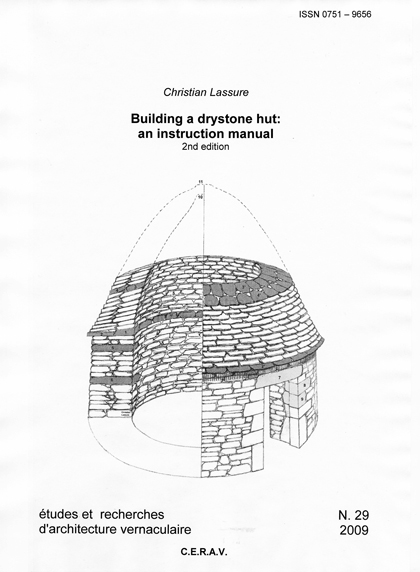|
1. INTRODUCTORY NOTE: DRYSTONE BUILDERS OF TODAY
2. OFFICIAL FORMALITIES
2.1 Prior notification of construction work, planning permission
2.2 Insurance
3. NUMBER OF PARTICIPANTS
3.1 "Too many cooks spoil the broth"
3.2 The advantages of working in tandem
4. CONSTRUCTION MATERIAL
4.1 Volume of stone required
4.2 The Source of Stone
4.3 Putting the stones in order
4.4 Carrying the stones to the building site
4.5 Laying the stones in the work area
4.6 Shifting the stone on-site
4.7 Stone handling
5. TOOLS
5.1 Clearing the building-plot
5.2 Splitting the strata of rocky outcrops
5.3 Breaking up big blocks
5.4 Lifting half-buried stone
5.5 Digging stoney ground
5.6 Rough-hewing stone
5.7 Levelling up the stone facing
5.8 Wedging stone properly
5.9 Laying out the foundations
5.10 Making sure the wall has the same batter throughout
5.11 Putting the lintel and inner-lintel in place
5.12 Covering the extrados of the vault with earth
6. SHAPING THE STONES
6.1 Raw or worked materials?
6.2 Rough-hewing
6.3 Levelling up the stone facing
6.4 Giving a chamfered edge to the stone facing of a corbelled vault
7. BUILDING THE WALLS AND FOUNDATIONS
7.1 The ground site
7.2 Foundations
7.3 Reconstruction of a hut whose walls and foundations have collapsed
7.4 The pivot
7.5 Moveable stands
7.6 External scaffolding
7.7 Laying the "first stone"
8. RULES OF GOOD DRYSTONE MASONRY
8.1 Laying the stones in alignment with their natural bedding
8.2 Laying stones according to the form of their upper and lower surfaces
8.3 Giving the outer facing a batter
8.4 Laying stones in horizontal courses
8.5 Staggered joints
8.6 Laying stones as headers, or bands
8.7 Laying throughbands at regular intervals |
|
8.8 Stabilizing stones in all six directions with wedges
8.9 Use of "grapeshot" to be avoided
8.10 Insulation with earth
8.11 Use of pinnings in the façing to be avoided
9. BUILDING AN ENTRANCE
9.1 The entrance’s placing
9.2 A doorway
9.3 A doorless entrance
9.4 Roofing technique for the entrance
10. CONSTRUCTING THE ROOFING
10.1 Floor
10.2 Pivot and slant-marking line
10.3 Ladder
10.4 Course of stone eaves plates (in cylindrical, conical huts)
10.5 Course of large blocks at the starting-point of the corbelling
10.6 Stones for the vaulting
10.7 The vault’s coping-stone or crown
10.8 Roof covering stones on the vault’s extrados
10.9 Stone cladding on the vault’s extrados
11. SPECIAL CASE: CONSTRUCTION OF A BUILDING ON A SQUARE PLAN
11.1 Four right-angles in the base part
11.2 A pyramid-shaped roof or a conical one with a flat-stone tiling?
11.3 The pyramid-shaped roof option
11.4 The conical stone-tiled roof option
12. FITTING OUT THE HUT’S INTERIOR
12.1 Construction of a niche
12.2 Construction of a window aperture
12.3 Construction of a seat
12.4 Flooring
12.5 Construction a fireplace
12.6 Putting in a coat hanger
13. SIGNING AND DATING THE CONSTRUCTION
14. WHAT TO DO WITH THE NEW BUILDING?
14.1 A ready-made use: toolshed, lumber room, storehouse
14.2 How to light up the interior
BIBLIOGRAPHICAL SOURCES
INSERTS
1 - Factory worker-builders of the capitelles
2 - The "two capitelles" constructed by Jean Castel and Pierre Paulet, "workers" of Nîmes, in 1620
3 - Distinguished amateurs
4 - The last of the builders of cabanons pointus
5 - The tools of dry stone builders in the Ardèche and Ariège départements (France), in the Catalan and Valencian countries (Spain)
6 - Irises and dry stone building
7 - Building of a dry stone hut (or capitelle) in 2004-2005 |
